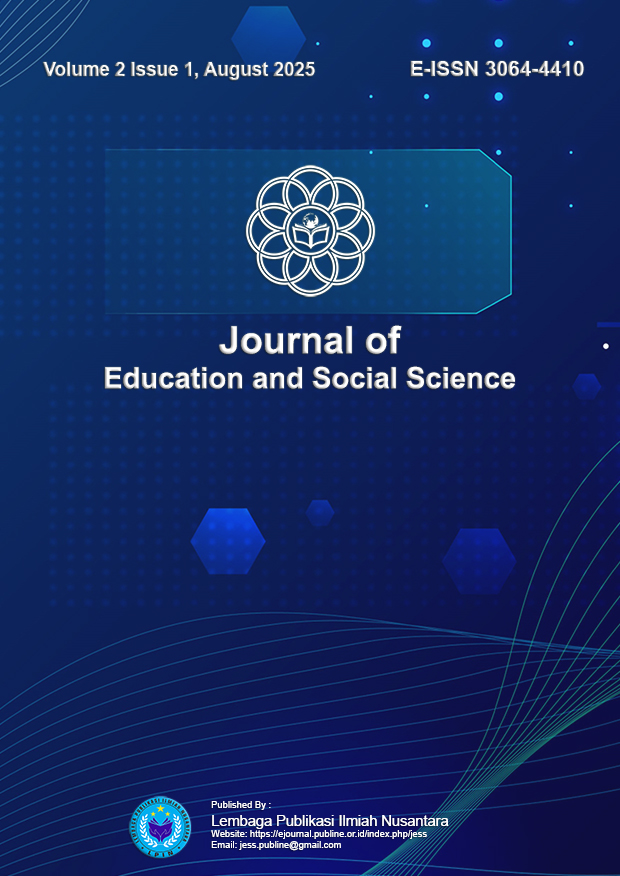The Impact of Using Augmented Reality-Based Interactive Media on Students' Learning Motivation
DOI:
https://doi.org/10.70716/jess.v2i1.181Keywords:
augmented reality, interactive media, learning motivation, educational technology, student engagementAbstract
This study investigates the impact of utilizing Augmented Reality (AR)-based interactive media on students' learning motivation. The research adopts a quasi-experimental method with a pretest-posttest control group design, involving middle school students who were divided into experimental and control groups. The experimental group used AR-based interactive media during the learning process, while the control group experienced conventional instructional methods. Data were collected through motivation questionnaires and observations, and were analyzed statistically to determine the differences between the two groups. The results reveal that students exposed to AR-based media demonstrated significantly higher motivation levels compared to those taught using traditional approaches. The use of AR enhanced students' interest, engagement, and participation during lessons, offering a more immersive and stimulating educational experience. Furthermore, the interactive features of AR allowed students to better visualize complex concepts, leading to improved comprehension and retention. These findings suggest that incorporating AR technology into educational settings can be an effective means of fostering student motivation and optimizing learning outcomes. Educators and policymakers are encouraged to consider the integration of innovative technologies like AR to create more dynamic and motivating learning environments that meet the needs of 21st-century learners.
Downloads
References
Akçayır, M., & Akçayır, G. (2017). Advantages and challenges associated with augmented reality for education: A systematic review of the literature. Educational Research Review, 20, 1–11. https://doi.org/10.1016/j.edurev.2016.11.002
Azuma, R. T. (1997). A survey of augmented reality. Presence: Teleoperators and Virtual Environments, 6(4), 355–385. https://doi.org/10.1162/pres.1997.6.4.355
Bacca, J., Baldiris, S., Fabregat, R., Graf, S., & Kinshuk. (2014). Augmented reality trends in education: A systematic review of research and applications. Educational Technology & Society, 17(4), 133–149.
Bandura, A. (1997). Self-efficacy: The exercise of control. W. H. Freeman and Company.
Billinghurst, M., & Duenser, A. (2012). Augmented reality in the classroom. Computer, 45(7), 56–63. DOI: 10.1109/MC.2012.111
Creswell, J. W. (2014). Research Design: Qualitative, Quantitative, and Mixed Methods Approaches (4th ed.). SAGE Publications.
Deci, E. L., & Ryan, R. M. (1985). Intrinsic motivation and self-determination in human behavior. Springer Science & Business Media.
Deci, E. L., & Ryan, R. M. (2000). The "what" and "why" of goal pursuits: Human needs and the self-determination of behavior. Psychological Inquiry, 11(4), 227–268. https://doi.org/10.1207/S15327965PLI1104_01
Dunleavy, M., & Dede, C. (2013). Augmented reality teaching and learning. Handbook of research on educational communications and technology, 735-745.https://doi.org/10.1007/978-1-4614-3185-5_59
Fleming, N. D., & Mills, C. (1992). Not another inventory, rather a catalyst for reflection. To Improve the Academy, 11(1), 137–155. https://doi.org/10.1002/j.2334-4822.1992.tb00213.x
Ibáñez, M.-B., & Delgado-Kloos, C. (2018). Augmented reality for STEM learning: A systematic review. Computers & Education, 123, 109–123. https://doi.org/10.1016/j.compedu.2018.05.002
Johnson, L., Adams Becker, S., Cummins, M., Estrada, V., Freeman, A., & Hall, C. (2016). NMC Horizon Report: 2016 K–12 Edition. The New Media Consortium.
Makransky, G., & Lilleholt, L. (2018). A structural equation modeling investigation of the emotional value of immersive virtual reality in education. Educational Technology Research and Development, 66(5), 1141–1164.
Pintrich, P. R., Smith, D. A., Garcia, T., & McKeachie, W. J. (1991). A manual for the use of the Motivated Strategies for Learning Questionnaire (MSLQ). University of Michigan, National Center for Research to Improve Postsecondary Teaching and Learning.
Radu, I. (2014). Augmented reality in education: A meta-review and cross-media analysis. Personal and Ubiquitous Computing, 18(6), 1533–1543.
Schunk, D. H., Pintrich, P. R., & Meece, J. L. (2014). Motivation in education: Theory, research, and applications (4th ed.). Pearson Higher Ed.
Wigfield, A., & Eccles, J. S. (2000). Expectancy–value theory of achievement motivation. Contemporary Educational Psychology, 25(1), 68–81. https://doi.org/10.1006/ceps.1999.1015
Wu, H. K., Lee, S. W. Y., Chang, H. Y., & Liang, J. C. (2013). Current status, opportunities and challenges of augmented reality in education. Computers & Education, 62, 41–49. https://doi.org/10.1016/j.compedu.2012.10.024
Downloads
Published
How to Cite
Issue
Section
License
Copyright (c) 2025 Burhanuddin Annail, Adib Alim Aminullah, Abdul Ghafur

This work is licensed under a Creative Commons Attribution-ShareAlike 4.0 International License.











